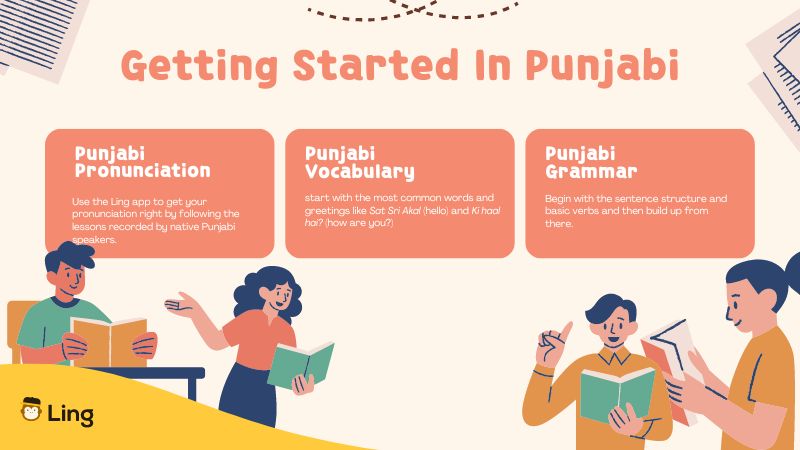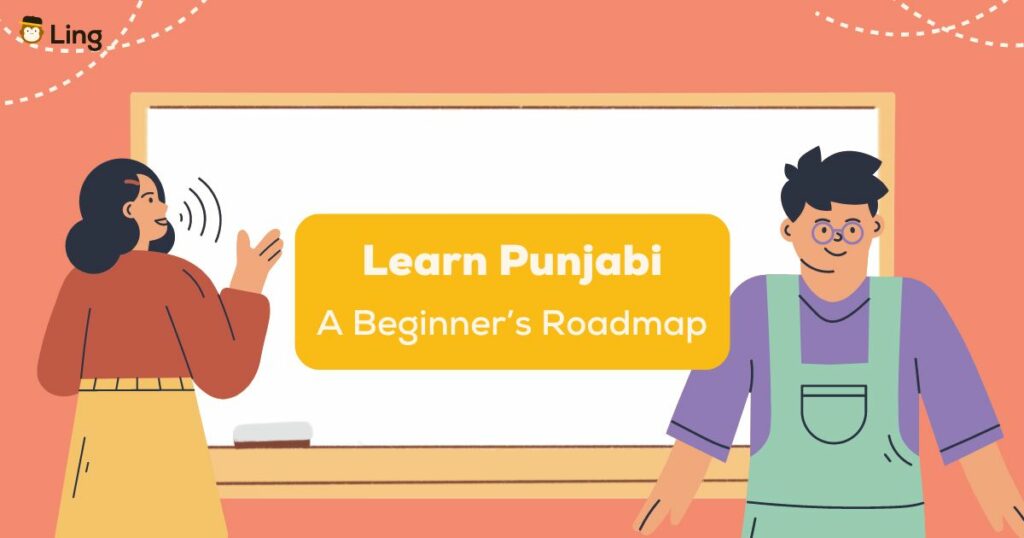I am a Hindi native speaker who grew up in Delhi, India. And I think that was reason enough for me to understand basic Punjabi phrases. You see, Delhi has a lot of Punjabi influence – whether it is the food or the language. I had many Punjabi friends and I picked up Punjabi vocabulary from their conversations. It was only later, as an adult, that I started to learn the Punjabi language a bit more seriously – yet not formally. And when I say formally, I mean joining Punjabi classes or doing any Punjabi language courses. I learned it on my own, in the most organic manner possible, without spending any money.
So, in this blog post, I aim to share the highs and lows of my Punjabi learning journey with you. This is a beginner’s roadmap to learn a language free. I’ll provide practical tips and insights that can help you navigate your own path when it comes to learning Punjabi. Whether you’re learning for personal enrichment, to connect with family, or for professional reasons, I hope that my experiences and strategies will give you a head start and keep you motivated.
Table Of Contents
How To Learn A New Language By Yourself
My Punjabi Learning Story
The path to learning any new language consciously – and not simply absorbing it from your surroundings – is an intentional path. What does that mean? Let me explain. So, as I mentioned, I grew up among Punjabi friends, listening to their conversations with each other and with their parents, listening to some great Punjabi songs with them.
So, during that time, I was not on an intentional language-learning journey. I was simply absorbing common Punjabi phrases and vocabulary used in daily conversations. However, I consciously started learning Punjabi only years later – when I went to college and developed a penchant for Sufi philosophy, thanks to my love for Punjabi Sufi and folk music.
And I only got around to learning other Punjabi language skills like reading and writing when I started working professionally. This is when my Punjabi language acquisition was intentional – I was seeking resources and tools to help me read and write the Punjabi alphabet and the writing system. I also made a decision to seriously learn the Punjabi grammar.
A Beginner’s Roadmap To Learn A Language Free
Find Your Motivation
What is the first step to learning a language? Well, the first step to learning a language is asking yourself – why am I choosing this language? What is my motivation? Learning must always be tied to a motivation, even if not necessarily a goal.
When I chose to seriously learn the Punjabi writing system, I knew my motivation was professional – I wanted to be able to read and write the language as I was working on a lot of Punjabi content, and I wanted to do it with honesty.
Plus, learning Punjabi alphabet also opened up a world of literature for me. It was exhilarating to be able to read the newspapers and books in Punjabi. And the cherry on the top was reading Punjabi poems since some of my favorite poets are doyens of Punjabi literature – Shiv Kumar Batalvi and Amrita Pritam.
Set Goals: My Personal Plan
While on my Punjabi learning journey, I found out that it is important to define clear short-term and long-term goals. Since I had already started working on Punjabi content, I needed to be able to read the Punjabi script as a priority. So, I set that as my short term goal while being able to write Punjabi alphabet using a pen and paper was the long-term goal.
I promised myself that I would spend an hour a day to learn to write the alphabet in the first week of my learning. And I felt so proud of myself when I could read a short paragraph in the Punjabi language without any help. But to be honest, even though Punjabi uses a different script than Hindi, it was relatively easier to read because I already knew how to read Hindi. Confusing?
You see, Hindi and Punjabi scripts do have some similarities. Gurmukhi and Devanagari are two distinct scripts used primarily in the northern regions of India. While they serve different languages—Gurmukhi for Punjabi and Devanagari for Hindi, Marathi, and Sanskrit—they share a number of similarities.
Gurmukhi and Devanagari scripts both have a similar number of consonants, organized in a similar phonetic order. For instance, the first five consonants in both scripts represent the velar, palatal, retroflex, dental, and labial sounds.
Gurmukhi: ਕ (ka), ਖ (kha), ਗ (ga), ਘ (gha), ਙ (nga)
Devanagari: क (ka), ख (kha), ग (ga), घ (gha), ङ (nga)
Find The Best Resources For Punjabi
The journey of finding the right resources was both challenging and rewarding. I started with the basics: a beginner’s textbook for Punjabi grammar and an app called Ling. The best part about using the Ling app was its finger tracing feature which helped me learn and, thereafter, practice the Punjabi alphabet. I could easily memorize the shape of the letter by practicing it as many times as I wanted on the Ling app.
For more immersive learning, I started following blogs published in the Punjabi language. I chose to follow blogs because they are more contemporary and I could find those matching my area of interest.
One of my best discoveries was a YouTube channel dedicated to teaching Punjabi through storytelling. Engaging with the Punjabi community online, through forums and social media groups, also provided support and practice opportunities.

Getting Started: The Basics
Tackling Punjabi Pronunciation
Now, coming from a Hindi speaking background, Punjabi pronunciation was not “that” daunting for me. Still, I did face slight challenges when speaking certain words.
But I do understand that Punjabi pronunciation can be daunting for a majority of people, especially with sounds not present in their native language. I have seen my colleagues from different countries struggling with the guttural kh sound (mainu kakh nahi aunda – I don’t know anything!) and the rolling r.
So, if you too face a similar issue with pronunciation, I would recommend you to check apps like Ling where the lessons are recorded by Punjabi native speakers. This gives you an opportunity to learn the actual sound and know what that alphabets “sound” like.
Tip
Additionally, you can practice by listening to Punjabi songs and repeating them yourselves. Singing along to popular tracks like “Lahore” by Guru Randhawa will not only improve your pronunciation but also make learning fun while you shake your body to some foot-tapping Punjabi music.
Build A Basic Punjabi Vocabulary Glossary
Ok, in all honesty, my first Punjabi words and phrases were not grasped via intentional learning. As I said earlier, I just absorbed them since childhood. But if you are learning Punjabi for the first time, then it is always a good idea to start from the basics.
You can start with the most common words and phrases: Greetings like Sat Sri Akal (hello) and everyday expressions like Ki haal hai? (How are you?) You can also use flashcards and the spaced repetition system (SRS) on apps like Anki to retain these words.
Mnemonics are also incredibly helpful. For instance, you can remember paani (water) by associating it with the English word “pan” and imagining a pan full of water.
Tip
You can go the traditional route and stick little post-it notes on all the objects in your room carrying the objects’ names in the Punjabi language. So, every time you use your work desk, you would know that you are using a mez (table) and kursi (chair). Every time you lie down on your bistara, you’d know that you are thinking about your bed.
Understand Basic Punjabi Grammar
Grammar is the backbone of any language, and Punjabi is no different. I began with the simplest structures: subject-object-verb (SOV) order. Again, it came easily to me because Hindi also uses the same sentence structure.
For example, “I eat an apple” translates to Main seb khandi haan which literally translates to, “I apple eat am.” Point to remember, Punjabi grammar, just like Hindi, has gender. It means that the nouns and pronouns are gendered and the verbs will conjugate according to the gender of the subject.
So, in case the speaker or subject is a male, the above sentence would be” Main seb khaanda haan.
Tip
Practicing these structures through simple sentences can help you understand the syntax. Pick up the top 10 verbs that are used daily. Or, take a look at your routine and note down the actions that you do daily. And then start using them in Punjabi sentences and speak them aloud to yourself or to your friends and family.
| English | Punjabi | Pronunciation | Male | Female |
|---|---|---|---|---|
| To do | ਕਰਨਾ | Karana | Oh kaam karda hai – He does the work | Oh kaam kardi hai – She does the work |
| To eat | ਖਾਣਾ | Khaana | Oh roti khaanda hai – He eats bread | Oh roti khaandi hai – She eats bread |
| To drink | ਪੀਣਾ | Peena | Oh paani peenda hai – He drinks water | Oh paani peendi hai – She drinks water |
| To go | ਜਾਣਾ | Jaana | Oh school jaanda hai – He goes to school | (Oh school jaandi hai – She goes to school |
| To come | ਆਉਣਾ | Aauna | Oh ghar aunda hai – He comes home | Oh ghar aundi hai – She comes home |
| To sleep | ਸੋਣਾ | Sona | Oh raat nu saunda hai – He sleeps at night | Oh raat nu saundi hai – She sleeps at night |
| To speak | ਬੋਲਣਾ | Bolana | Oh Punjabi bolda hai – He speaks Punjabi | Oh Punjabi boldi hai – She speaks Punjabi |
| To see | ਦੇਖਣਾ | Dekhana | Oh kitaab parhda hai – He reads a book | Oh kitaab parhdi hai – She reads a book |
| To read | ਪੜ੍ਹਨਾ | Padhana | Oh chithi likhda hai – He writes a letter | Oh chithi likhdi hai – She writes a letter |
| To write | ਲਿਖਣਾ | Likhana | Oh film dekhda hai – He watches a movie | Oh film dekhdi hai – She watches a movie |
Develop Intermediate Skills
Expand Your Punjabi Vocabulary
As you move to intermediate learning, expanding your vocabulary is key. You can focus on thematic lists, such as food, travel, and emotions. Using resources like the Ling app and vocabulary lists from language courses like Learn101, you can aim to learn around 10 new words daily.
Tip
Contextual learning plays a big role. For instance, you can jot down new words and phrases while watching Punjabi movies. There are many wholesome Punjabi movies on Netflix that you can use in your language leaning journey. This not only enriches your vocabulary but also provides a lot of cultural context to the words you are learning.
For instance, you’ll have a clearer idea of when to use tusi (“you” – formal, respect) and with whom to use tu (“you” – informal).
Improve Punjabi Listening Skills
Listening comprehension is essential to learn a foreign language. That’s why it is beneficial to immerse yourself in the language through Punjabi media. I started with Punjabi music, gradually moving to podcasts and Punjabi movies. One of my favorite Punjabi movies is Lahoriye, which offered both entertainment (great music and storytelling) and a wealth of new vocabulary.
Tip
With movies as your learning resource, you can practice by listening to dialogues repeatedly, focusing on understanding context and nuances. Interactive listening exercises from platforms like Ling can also help you hone your target language skills.
Speak Punjabi With Confidence
Building speaking confidence takes time and effort. However, you can always take steady, even if small, steps in building your speaking confidence. You can join language exchange platforms like Ling Discord to converse with native speakers.
Tip
Recording yourself speaking and listening to the playback allows you to identify and correct mistakes. Participating in Punjabi cultural events and festivals can also give you real-life speaking practice and may help boost your confidence. So, search for a friend or colleague who is celebrating a Punjabi festival and request them to bring you with them. Believe me, you’ll have great fun!
Enhance Reading And Writing In Punjabi
Reading and writing were integral to my language learning journey, as I mentioned earlier. I started with children’s books and short stories, gradually progressing to more complex texts. I also started following Punjabi threads on Twitter where I could read and write posts and comments in Punjabi.
Tip
Seeking feedback from native speakers and tutors is also an invaluable step that helps you refine your skills and gain confidence.
Maintain And Improve Fluency
Language learning is a continuous process. To maintain and improve my fluency, I made Punjabi a part of my daily routine. I read Punjabi newspapers, watched Punjabi news channels, and stayed connected with my language exchange partners.
And when you feel ready for the next step, you can then look for advanced courses, like those offered by the Punjabi teaching government certified institutes if you wish to learn it formally. However, they are not free resources and you would have to spend a fair amount of money to get that certificate.
Overcome Common Challenges In Learning Punjabi
Learning Punjabi, like any language, can come with its challenges. I experienced plateaus where progress seemed slow, and frustration was common. To overcome these, I diversified my learning methods and stayed consistent with my practice.
Time management was another hurdle as I was working full time and had other responsibilities and another language class going parallel. But setting aside dedicated study time each day helped. Plus, the timely reminders from the Ling app every night helped me be regular with my Punjabi lessons even on days when I didn’t have time to catch a breath!
Stay Motivated
Staying motivated was essential for long-term success. I set new goals and challenges, like reading a Punjabi novel or holding a conversation without switching to English. This was challenging because Punjabi has so many English loanwords in its vocabulary but still, I persisted.
Tip
Celebrating milestones, no matter how small, helps you to keep encouraged. Whether it is understanding a song lyric or successfully communicating with a native speaker, allow each achievement to fuel your motivation to keep going. I would treat myself to my favorite Punjabi dessert – pinni – when I wanted to celebrate a milestone.
FAQs About How To Learn A Language For Beginners
What Is The Correct Order To Learn A Language?
The correct order is to start with basic pronunciation and phonetics, then move to foundational vocabulary and simple grammar. Follow this with developing listening and speaking skills, expanding vocabulary, and practicing reading and writing. Immersive practice and cultural understanding enhance fluency.
What Should I Do First To Learn A Language?
Begin by learning the alphabet and sounds of the language. Focus on basic greetings, essential phrases, and simple vocabulary. Use language learning apps, flashcards, and audio resources to familiarize yourself with pronunciation and common expressions.
Is Duolingo Enough To Learn A Language?
No, Duolingo could be a great starting point for learning basic vocabulary and phrases. However, it does not provide any grammar explanation or gives any cultural context. The Ling app aces these two aspects, apart from helping you learn the Punjabi alphabet by the finger-tracing feature. It also offers lessons recorded by native speakers to help you understand how the language actually “sounds.”
Start Your Punjabi Learning Journey With Ling
Don’t wait to start your Punjabi learning journey. Access the recommended tools and resources shared in this guide, and begin with confidence and enthusiasm. Ans what should be your first step? To download the Ling app for a super smooth “first foot in the door.” Yes, Ling provides you access to all the best features that technology can assist you with in your Punjabi learning journey.
Remember, the key to success is consistent practice and a positive attitude. You can start with the basics – and then gradually build up from there. Agreed, you can’t learn an entire language with an app but the Ling app provides you the discipline and the motivation to keep at it. It’s comprehensive Punjabi course is ably supported by various complementary features like grammar and culture notes, finger-tracing method, customized learning path, pronunciation practice with the AI Chatbot, a progress tracker and daily reminders.
You can download the Ling app at the App Store or the Google Play Store and get started today!



































































